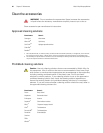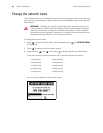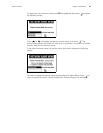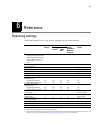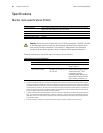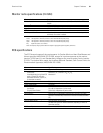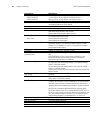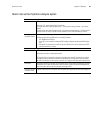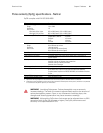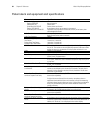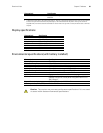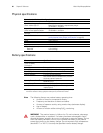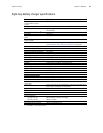
54 Chapter 6 Reference Welch Allyn Micropaq Monitor
Common Mode Rejection
FILTER function OFF
FILTER function ON
<1 mV p-p RTI for 10V rms, 50/60 Hz into unbalanced input
<30 µV p-p RTI for 10V rms, 50/60 Hz into unbalanced input
Input Impedance >2.5 M¾ differential @ 60 Hz
Input Range (ac) 10 mV peak to peak (local display)
10 mV peak to peak (Acuity Central Station)
Input Range (dc) Up to ±500 mV
System Noise ð30 µV peak-to-peak, RTI
QRS Detector Adult or Pediatric Amplitude Range: 0.22 to 5.0 mV (RTI)
Adult Width Range (Duration): 70 to 120 msec
Pediatric Width Range (Duration): 40 to 120 msec
Heart Rate Range
Alarm Limits
25 to 350 beats per minute (measurement)
25 to 300 beats per minute (display)
25 to 245 beats per minute (lower)
30 to 250 beats per minute (upper)
Heart Rate Meter Response Time Responds to change in heart rate within 5 to 9 seconds depending on
physiological waveform. (As measured per AAMI standard EC13-1992
clause 4.1.2.1 (f), including 3.1.2.1 parts f. and g. waveforms.) Includes 1
second readout update interval.
HR Display Update Interval at monitor 1 second
HR Accuracy ±3 beats per minute or 3%, whichever is greater
Heart Rate Response to ineffectively
paced QRS pattern
Indicates rate of 30 to 46 during AAMI EC13-1992 part 3.1.4.1 part (f) and (g)
tests.
NOTE: AAMI Test 4.1.4 part f and g: Accuracy is affected (i.e., rate
increases) when QRS and pacer spikes are nearly simultaneous as
occasionally is the case during this AAMI test.
Heart Rate Averaging Method Heart rate = 60/ latest average interval in seconds.
For higher heart rates, latest average interval = 7/8 of previous average
interval + 1/8 of latest interval.
For lower heart rates, latest average interval = 3/4 of previous average
interval + 1/4 of latest interval.
Transition rates for choice of formula include hysteresis and are 70 and 80
beats per minute.
Drift Tolerance (AAMI Specification EC13-
1992, 3.2.6.3)
80 beats per minute indicated for 80 beats per minute ECG plus drift
waveform
Pacer Pulse Display Pacer indicator shown on screen if PACER display turned ON; pacer spike
always shown if of sufficient amplitude.
Pacer Pulse Rejection Pacer detection range (i.e., will show the dashed vertical marker) for ±3 mV
to ±700 mV @ 0.1 ms width, ±2 mV to ±700 mV @ 0.2 to 2 ms pulse width in
electrically quiet environment. Thresholds automatically adjust to reject
repetitive ambient noise. Operates even while pacer indication is disabled.
Will not count as heartbeats approximately 95% of pacemaker pulses
within pacer detection range, with or without AAMI (EC13-1992) tails of 4,
25, 50, 75, or 100 ms decay time constant, whose tail amplitudes are up to
25%, 2mV maximum, whether ventricular only, or A-V sequential pulses
(150 and 250 ms separation), all per AAMI tests 3.1.4.1 and 3.1.4.2
Response to Irregular Rhythm (AAMI Specification EC13-1992, 3.1.2.1. Part e.)
Ventricular Bigeminy (VB) 78 to 81 bpm (80 bpm expected)
Slow Alternating VB 57 to 65 bpm (60 bpm expected)
Rapid Alternating VB 118 to 123 bpm (120 bpm expected)
Bidirectional Systole 88 to 93 bpm (90 bpm expected)
Characteristic Specification



